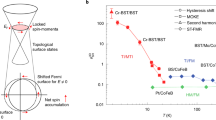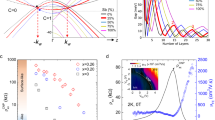Abstract
Three-dimensional topological crystalline insulators were recently predicted and observed in the SnTe class of IV–VI semiconductors, which host metallic surface states protected by crystal symmetries. In this work, we study thin films of these materials and expose their potential for device applications. We demonstrate that thin films of SnTe and Pb1−xSnxSe(Te) grown along the (001) direction are topologically non-trivial in a wide range of film thickness and carry conducting spin-filtered edge states that are protected by the (001) mirror symmetry through a topological invariant. Application of an electric field perpendicular to the film will break the mirror symmetry and generate a bandgap in these edge states. This functionality motivates us to propose a topological transistor device in which charge and spin transport are maximally entangled and simultaneously controlled by an electric field. The high on/off operation speed and coupling of spin and charge in such a device may lead to electronic and spintronic applications for topological crystalline insulators.
This is a preview of subscription content, access via your institution
Access options
Subscribe to this journal
Receive 12 print issues and online access
$259.00 per year
only $21.58 per issue
Buy this article
- Purchase on Springer Link
- Instant access to full article PDF
Prices may be subject to local taxes which are calculated during checkout






Similar content being viewed by others
References
Fu, L. & Kane, C. L. Topological insulators with inversion symmetry. Phys. Rev. B 76, 045302 (2007).
Teo, J. Y. C., Fu, L. & Kane, C. L. Surface states and topological invariants in three-dimensional topological insulators: Application to Bi1−xSbx . Phys. Rev. B 78, 045426 (2008).
Hasan, M. Z. & Kane, C. L. Colloquium: Topological insulators. Rev. Mod. Phys. 82, 3045–3067 (2010).
Qi, X. L. & Zhang, S. C. Topological insulators and superconductors. Rev. Mod. Phys. 83, 1057–1110 (2011).
Moore, J. E. The birth of topological insulators. Nature 464, 194–198 (2010).
Fu, L. Topological crystalline insulators. Phys. Rev. Lett. 106, 106802 (2011).
Hsieh, T. H. et al. Topological crystalline insulators in the SnTe material class. Nature Commun. 3, 982 (2012).
Tanaka, Y. et al. Experimental realization of a topological crystalline insulator in SnTe. Nature Phys. 8, 800–803 (2012).
Dziawa, P. et al. Topological crystalline insulator states in Pb1−xSnxSe. Nature Mater. 11, 1023–1027 (2012).
Xu, S. Y. et al. Observation of a topological crystalline insulator phase and topological phase transition in Pb1−xSnxTe. Nature Commun. 3, 1192 (2012).
Mong, R. S. K., Essin, A. M. & Moore, J. E. Antiferromagnetic topological insulators. Phys. Rev. B 81, 245209 (2010).
Okada, Y. et al. Observation of Dirac node formation and mass acquisition in a topological crystalline insulator. Science 341, 1496–1499 (2013).
Takahashi, R. & Murakami, S. Gapless interface states between topological insulators with opposite dirac velocities. Phys. Rev. Lett. 107, 166805 (2011).
Kargarian, M. & Fiete, G. A. Topological crystalline insulators in transition metal oxides. Phys. Rev. Lett. 110, 156403 (2013).
Chiu, C-K., Yao, H. & Ryu, S. Classification of topological insulators and superconductors in the presence of reflection symmetry. Phys. Rev. B 88, 075142 (2013).
Morimoto, T. & Furusaki, A. Topological classification with additional symmetries from Clifford algebras. Phys. Rev. B 88, 125129 (2013).
Ye, M., Allen, J. W. & Sun, K. Topological crystalline Kondo insulators and universal topological surface states of SmB6. Preprint at http://arxiv.org/abs/1307.7191 (2013).
Weng, H., Zhao, J., Wang, Z., Fang, Z. & Dai, X. Topological crystalline Kondo insulator in mixed valence ytterbium borides. Preprint at http://arxiv.org/abs/1308.5607 (2013).
Abanin, D. A., Lee, P. A. & Levitov, L. S. Spin-filtered edge states and quantum Hall effect in graphene. Phys. Rev. Lett. 96, 176803 (2006).
Young, A. F. et al. Tunable symmetry breaking and helical edge transport in a graphene quantum spin Hall state. Preprint at http://arxiv.org/abs/1307.5104 (2013).
Maher, P. et al. Evidence for a spin phase transition at charge neutrality in bilayer graphene. Nature Phys. 9, 154–158 (2013).
Kane, C. L. & Mele, E. J. Quantum spin Hall effect in graphene. Phys. Rev. Lett. 95, 226801 (2005).
Kane, C. L. & Mele, E. J. Z2 topological order and the quantum spin Hall effect. Phys. Rev. Lett. 95, 146802 (2005).
Bauer, G. & Springholz, G. Molecular beam epitaxy of IV–VI semiconductor hetero- and nano-structures. Phys. Status Solidi B 244, 2752–2767 (2007).
Abramof, E., Ferreira, S. O., Rappl, P. H. O., Closs, H. & Bandeira, I. N. Electrical properties of Pb1−xSnxTe layers with grown by molecular beam epitaxy. J. Appl. Phys. 82, 2405–2410 (1997).
Ishida, A. et al. Electrical and thermoelectrical properties of SnTe-based films and superlattices. Appl. Phys. Lett. 95, 122106 (2009).
Liu, J., Duan, W. & Fu, L. Two types of surface states in topological crystalline insulators. Phys. Rev. B (in the press); preprint at http://arxiv.org/abs/1304.0430 (2013).
Fang, C., Gilbert, M. J., Xu, S-Y., Bernevig, B. A. & Hasan, M. Z. Theory of quasiparticle interference in mirror-symmetric two-dimensional systems and its application to surface states of topological crystalline insulators. Phys. Rev. B 88, 125141 (2013).
Wang, Y. J. et al. Nontrivial spin texture of the coaxial Dirac cones on the surface of topological crystalline insulator SnTe. Phys. Rev. B 87, 235317 (2013).
Safaei, S., Kacman, P. & Buczko, R. Topological crystalline insulator (Pb,Sn)Te: Surface states and their spin polarization. Phys. Rev. B 88, 045305 (2013).
Lent, C. S. et al. Relativistic empirical tight-binding theory of the energy bands of GeTe, SnTe, PbTe, PbSe, PbS, and their alloys. Superlatt. Microstruct. 2, 491–499 (1986).
Lopez Sancho, M. P., Lopez Sancho, J. M. & Rubio, J. Highly convergent schemes for the calculation of bulk and surface Green functions. J. Phys. F 15, 851 (1985).
Du, L., Knez, I., Sullivan, G. & Du, R. Observation of quantum spin Hall states in InAs/GaSb bilayers under broken time-reversal symmetry. Preprint at http://arxiv.org/abs/1306.1925 (2013).
Lang, M. et al. Competing weak localization and weak antilocalization in ultrathin topological insulators. Nano Lett. 13, 48–53 (2013).
Khokhlov, D. Lead Chalcogenides: Physics and Applications (CRC, 2002).
Ishida, A., Aoki, M. & Fujiyasu, H. Semimetallic Hall properties of PbTe–SnTe superlattice. J. Appl. Phys. 58, 1901–1903 (1985).
Rogacheva, E. I. et al. Quantum size effects in n-PbTe/p-SnTe/n-PbTe heterostructures. Appl. Phys. Lett. 86, 063103 (2005).
Taskin, A. A., Sasaki, S., Segawa, K. & Ando, Y. Topological surface transport in epitaxial SnTe thin films grown on Bi2Te3. Preprint at http://arxiv.org/abs/1305.2470 (2013).
Grabecki, G. et al. PbTe—A new medium for quantum ballistic devices. Physica E 34, 560–563 (2006).
Fang, C., Gilbert, M. J. & Bernevig, B. A. Large Chern number quantum anomalous Hall effect in thin-film topological crystalline insulators. Preprint at http://arxiv.org/abs/1306.0888 (2013).
Zhang, F., Li, X., Feng, J., Kane, C. L. & Mele, E. J. Zeeman field-tuned transitions for surface chern insulators. Preprint at http://arxiv.org/abs/1309.7682 (2013).
Fang, Z. et al. The anomalous Hall effect and magnetic monopoles in momentum space. Science 302, 92–95 (2003).
Acknowledgements
We thank Y. Ando and A. Young for helpful comments and suggestions. This work is supported by the US Department of Energy, Office of Basic Energy Sciences, Division of Materials Sciences and Engineering under Award DE-SC0010526. T.H.H. acknowledges support under NSF Graduate Research Fellowship No. 0645960. J.L and W.D. acknowledge support from the Ministry of Science and Technology of China (Grant Nos 2011CB921901 and 2011CB606405) and the National Natural Science Foundation of China (Grant No. 11074139). P.W. and J.M. are grateful for support from the MIT MRSEC through the MRSEC Program of the NSF under award number DMR-0819762, as well as NSF DMR grants 1207469 and ONR grant N00014-13-1-0301.
Author information
Authors and Affiliations
Contributions
J.L. performed band-structure and mirror Chern number calculations. T.H.H. performed theoretical analysis with contributions from J.L. T.H.H. and L.F. wrote the manuscript with contributions from all authors. L.F. conceived and supervised the project. All correspondence should be addressed to L.F.
Corresponding author
Ethics declarations
Competing interests
The authors declare no competing financial interests.
Rights and permissions
About this article
Cite this article
Liu, J., Hsieh, T., Wei, P. et al. Spin-filtered edge states with an electrically tunable gap in a two-dimensional topological crystalline insulator. Nature Mater 13, 178–183 (2014). https://doi.org/10.1038/nmat3828
Received:
Accepted:
Published:
Issue Date:
DOI: https://doi.org/10.1038/nmat3828
This article is cited by
-
Achieving environmental stability in an atomically thin quantum spin Hall insulator via graphene intercalation
Nature Communications (2024)
-
Axially lattice-matched wurtzite/rock-salt GaAs/Pb1−xSnxTe nanowires
Scientific Reports (2024)
-
Proximity induced band gap opening in topological-magnetic heterostructure (Ni80Fe20/p-TlBiSe2/p-Si) under ambient condition
Scientific Reports (2023)
-
Acoustic realization of projective mirror Chern insulators
Communications Physics (2023)
-
Two-dimensional rectangular bismuth bilayer: A novel dual topological insulator
Frontiers of Physics (2023)



